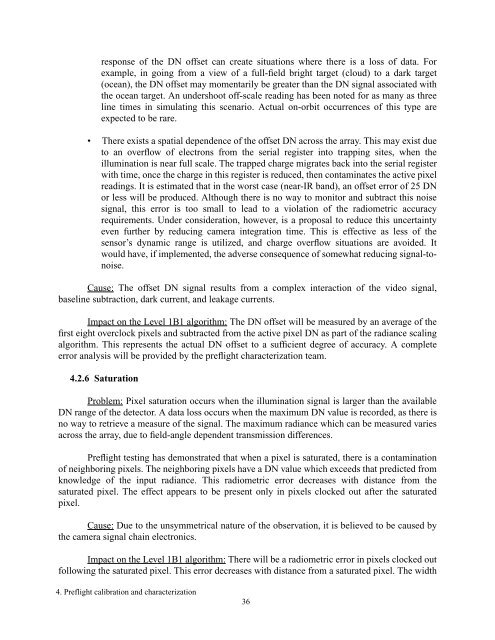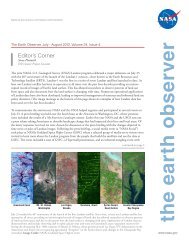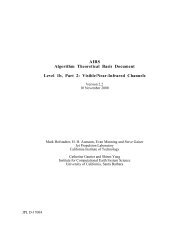MISR: In-Flight Radiometric Calibration and Characterization Plan
MISR: In-Flight Radiometric Calibration and Characterization Plan
MISR: In-Flight Radiometric Calibration and Characterization Plan
Create successful ePaper yourself
Turn your PDF publications into a flip-book with our unique Google optimized e-Paper software.
esponse of the DN offset can create situations where there is a loss of data. Forexample, in going from a view of a full-field bright target (cloud) to a dark target(ocean), the DN offset may momentarily be greater than the DN signal associated withthe ocean target. An undershoot off-scale reading has been noted for as many as threeline times in simulating this scenario. Actual on-orbit occurrences of this type areexpected to be rare.• There exists a spatial dependence of the offset DN across the array. This may exist dueto an overflow of electrons from the serial register into trapping sites, when theillumination is near full scale. The trapped charge migrates back into the serial registerwith time, once the charge in this register is reduced, then contaminates the active pixelreadings. It is estimated that in the worst case (near-IR b<strong>and</strong>), an offset error of 25 DNor less will be produced. Although there is no way to monitor <strong>and</strong> subtract this noisesignal, this error is too small to lead to a violation of the radiometric accuracyrequirements. Under consideration, however, is a proposal to reduce this uncertaintyeven further by reducing camera integration time. This is effective as less of thesensor’s dynamic range is utilized, <strong>and</strong> charge overflow situations are avoided. Itwould have, if implemented, the adverse consequence of somewhat reducing signal-tonoise.Cause: The offset DN signal results from a complex interaction of the video signal,baseline subtraction, dark current, <strong>and</strong> leakage currents.Impact on the Level 1B1 algorithm: The DN offset will be measured by an average of thefirst eight overclock pixels <strong>and</strong> subtracted from the active pixel DN as part of the radiance scalingalgorithm. This represents the actual DN offset to a sufficient degree of accuracy. A completeerror analysis will be provided by the preflight characterization team.4.2.6 SaturationProblem: Pixel saturation occurs when the illumination signal is larger than the availableDN range of the detector. A data loss occurs when the maximum DN value is recorded, as there isno way to retrieve a measure of the signal. The maximum radiance which can be measured variesacross the array, due to field-angle dependent transmission differences.Preflight testing has demonstrated that when a pixel is saturated, there is a contaminationof neighboring pixels. The neighboring pixels have a DN value which exceeds that predicted fromknowledge of the input radiance. This radiometric error decreases with distance from thesaturated pixel. The effect appears to be present only in pixels clocked out after the saturatedpixel.Cause: Due to the unsymmetrical nature of the observation, it is believed to be caused bythe camera signal chain electronics.Impact on the Level 1B1 algorithm: There will be a radiometric error in pixels clocked outfollowing the saturated pixel. This error decreases with distance from a saturated pixel. The width4. Preflight calibration <strong>and</strong> characterization36







